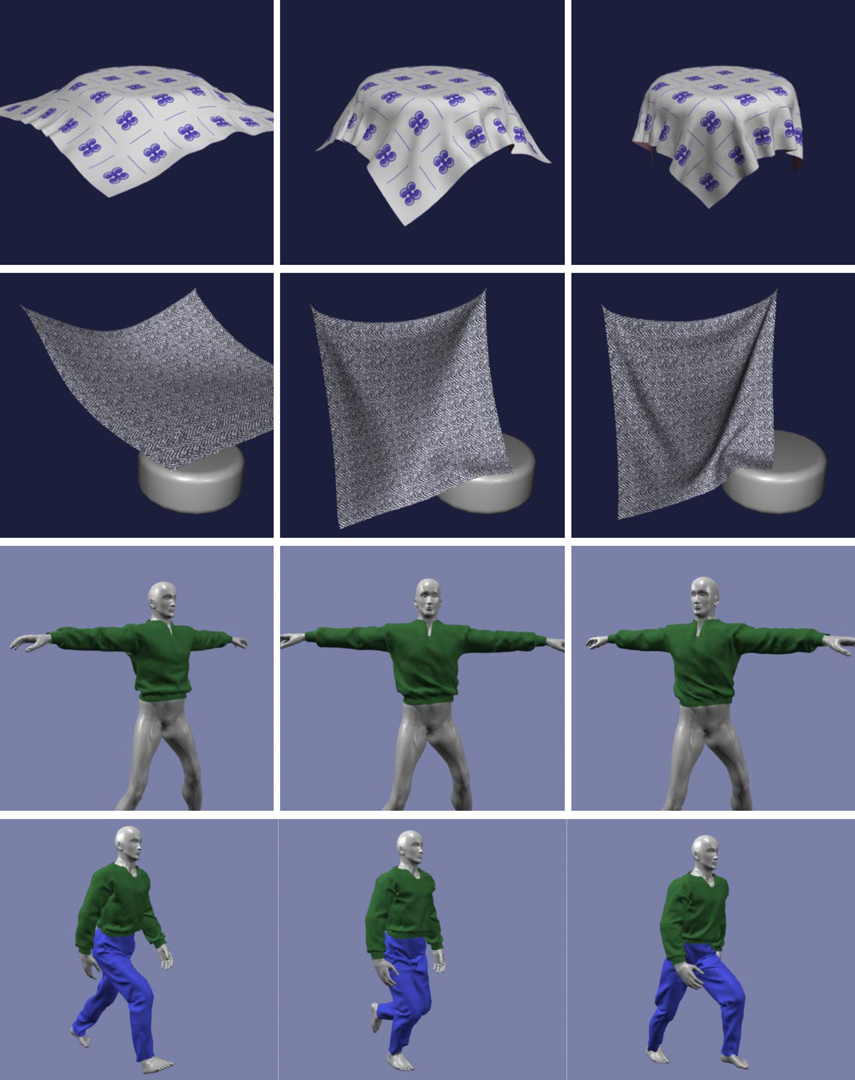“Large steps in cloth simulation” by Baraff and Witkin
Conference:
Type(s):
Title:
- Large steps in cloth simulation
Presenter(s)/Author(s):
Abstract:
The bottle-neck in most cloth simulation systems is that time steps must be small to avoid numerical instability. This paper describes a cloth simulation system that can stably take large time steps. The simulation system couples a new technique for enforcing constraints on individual cloth particles with an implicit integration method. The simulator models cloth as a triangular mesh, with internal cloth forces derived using a simple continuum formulation that supports modeling operations such as local anisotropic stretch or compression; a unified treatment of damping forces is included as well. The implicit integration method generates a large, unbanded sparse linear system at each time step which is solved using a modified conjugate gradient method that simultaneously enforces particles’ constraints. The constraints are always maintained exactly, independent of the number of conjugate gradient iterations, which is typically small. The resulting simulation system is significantly faster than previous accounts of cloth simulation systems in the literature.
References:
1. D. Baraff. Dynamic Simulation of Non-penetrating Rigid Bodies. PhD thesis, Cornell University, May 1992.
2. D. Baraff. Fast contact force computation for nonpenetrating rigid bodies. Computer Graphics (Proc. SIGGRAPH), 28:23- 34, 1994.
3. D.E. Breen, D.H. House, and M.J. Wozny. Predicting the drape of woven cloth using interacting particles. Computer Graphics (Proc. SIGGRAPH), pages 365-372, 1994.
4. M. Carignan, Y. Yang, N. Magenenat-Thalmann, and D. Thaimann. Dressing animated synthetic actors with complex deformable clothes. Computer Graphics (Proc. SIGGRAPH), pages 99-104, 1992.
5. B. Eberhardt, A. Weber, and W. Strasser. A fast, flexible, particle-system model for cloth draping. IEEE Computer Graphics and Applications, 16:52-59, 1996.
6. G. Golub and C. Van Loan. Matrix Computations. John Hopkins University Press, 1983.
7. M. Kass. An Introduction To Physically Based Modeling, chapter Introduction to Continuum Dynamics for Computer Graphics. SIGGRAPH Course Notes, ACM SIGGRAPH, 1995.
8. M. Kass and G. Miller. Rapid, stable fluid dynamics for computer graphics. Computer Graphics (Proc. SIGGRAPH), pages 49-58, 1990.
9. H.N. Ng and R.L. Grimsdale. Computer graphics techniques for modeling cloth. IEEE Computer Graphics and Applications, 16:28-41, 1996.
10. H. Okabe, H. Imaoka, T. Tomiha, and H. Niwaya. Three dimensional apparel cad system. Computer Graphics (Proc. SIGGRAPH), pages 105-110, 1992.
11. J.C. Platt and A.H. Barr. Constraint methods for flexible models. In Computer Graphics (Proc. SIGGRAPH), volume 22, pages 279-288. ACM, July 1988.
12. W.H. Press, B.E Flannery, S.A. Teukolsky, and W.T. Vetterling. Numerical Recipes. Cambridge University Press, 1986.
13. X. Provot. Deformation constraints in a mass-spring model to describe rigid cloth behavior. In Graphics Interface, pages 147-155, 1995.
14. J. Shewchuk. An introduction to the conjugate gradient method without the agonizing pain. Technical Report CMU- CS-TR-94-125, Carnegie Mellon University, 1994. (See also http ://www. cs. cmu. edu/~quake-papers/ painless-conjugate-gradient, ps.).
15. D. Terzopoulos and K. Fleischer. Deformable models. Visual Computer, 4:306-331, 1988.
16. D. Terzopoulos and K. Fleischer. Modeling inelastic deformation: Viscoelasticity, plasticity, fracture. In Computer Graphics (Proc. SIGGRAPH), volume 22, pages 269-278. ACM, August 1988.
17. D. Terzopoulos, J.C. Platt, and A.H. Barr. Elastically deformable models. Computer Graphics (Proc. SIGGRAPH), 21:205-214, 1987.
18. D. Terzopoulos and H. Qin. Dynamics nurbs with geometric constraints for interactive sculpting. ACM Transactions on Graphics, 13:103-136, 1994.
19. X. Tu. Artificial Animals for Computer Animation: Biomechanics, Locomotion, Perception and Behavior. PhD thesis, University of Toronto, May 1996.
20. E Volino, M. Courchesne, and N. Magnenat Thalmann. Versatile and efficient techniques for simulating cloth and other deformable objects. Computer Graphics (Proc. SIGGRAPH), pages 137-144, 1995.
21. E Volino, N. Magnenat Thalmann, S. Jianhua, and D. Thaimann. An evolving system for simulating clothes on virtual actors. IEEE Computer Graphics and Applications, 16:42-51, 1996.




